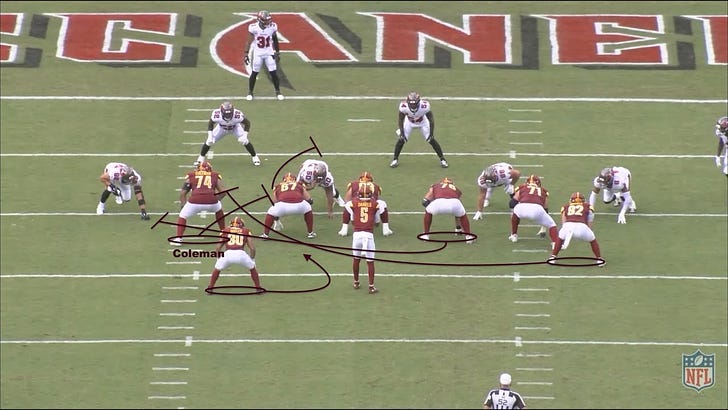How will Brandon Coleman handle shifting to guard?
Breaking down the challenges and upside of shifting Brandon Coleman from tackle to guard
The Commanders biggest move of the offseason was to trade for Texans left tackle Laremy Tunsil. Tunsil is one of the top left tackles in the NFL, which means incumbent left tackle Brandon Coleman, a third round pick in 2024, is moving position this offseason. Head coach Dan Quinn said prior to the draft that they would start working him at right tackle and go from there, but then the Commanders used their first round pick on offensive tackle Josh Conerly Jr. out of Oregon. Conerly looks set to shift from his left tackle position in college to right tackle in the NFL, which means Coleman will likely now kick inside to guard.
The good news for Coleman is that he has some experience playing left guard already, having played some in college. Many draft analysts projected him as a guard at the next level. The Commanders have been bullish on his ability to play tackle, but with Tunsil and Conerly likely the bookend tackles, the only available spot for Coleman to start at is guard. But is Coleman actually better suited to guard and how will that move mesh with his strengths and weaknesses? Let’s take a closer look.
Run blocking
As a run blocker, Coleman showed a lot of tenacity and the ability to move defenders off their spot last season. In a lot of their gap scheme runs, Coleman would be responsible for helping a guard secure a block inside before working up to the second level, which he proved effective at.
On this play against the Buccaneers, you can see a good example of what Coleman did well last year in the run game from the tackle spot. The Commanders call a counter scheme with the right guard pulling and kicking out on the edge while a tight end follows him and wraps around for a linebacker. Coleman, at left tackle, is responsible for working down inside to help the left guard secure his block before then working up to the second level to pin a linebacker inside and create a seal inside.
As the ball is snapped, you can see Coleman lands a powerful punch on the defensive tackle, shoving him inside to help position him better for left guard Nick Allegretti to try and seal him off. Coleman then peels off and works up to the next level, where he takes on the linebacker. Coleman gets some help from the scheme, which causes the linebacker to take a false step inside, giving Coleman an extra beat or two to make his block. But Coleman makes the most of that help, climbing to the linebacker and sealing him off inside. Unfortunately, Allegretti lost control of the defensive tackle who made the play, but Coleman did a nice job overall.
However, at guard, Coleman’s responsibility on a lot of these gap run schemes will be slightly different. Instead of helping the guard secure a block and then working up to the second level, Coleman will be the guard that has to secure the block on the defensive tackle inside. Fortunately, there were a few different instances where he had to do just that last season.
Here we see the Commanders in a fourth and one situation against the Giants. The Giants use a bigger front to try and stop the run, with three bigger interior lineman all lining up between the tackles. With nose tackle Dexter Lawrence the big threat over the center, left guard Nick Allegretti has to help inside, so Coleman is responsible for the defensive tackle in the gap between himself and Allegretti. Instead of being able to shove him inside and climb to the second level, Coleman has to secure the block by himself.
Coleman works quickly off the snap, getting a great jump and shuffling across inside to ensure the defender can’t immediately penetrate inside and blow up the run before it even begins. Byt getting inside the defender so quickly, Coleman puts pressure on the defender to try and get back inside and plug that gap. He does his best to work across Coleman’s face and get back inside, and Coleman takes advantage. He allows the defender to get inside and then uses his momentum against him to shove him even further inside, washing him down the line and out of the play. Running back Austin Ekeler runs right behind Coleman and picks up the first down as a result.
This wasn’t the only example of Coleman making a block you would more typically see from a guard than a tackle. The Commanders frequently used unbalanced formations, shifting a tackle over to the other side of the formation. This often put Coleman as the “tight end” outside the right tackle, but when it was flipped the other way, right tackle Andrew Wylie shifted over and played “tight end” outside of Coleman.
Keep reading with a 7-day free trial
Subscribe to Bullock's Film Room to keep reading this post and get 7 days of free access to the full post archives.



